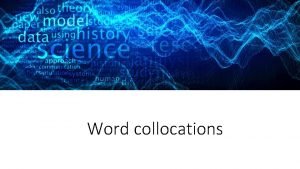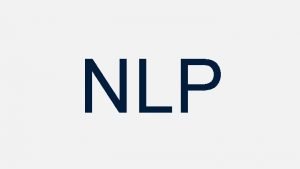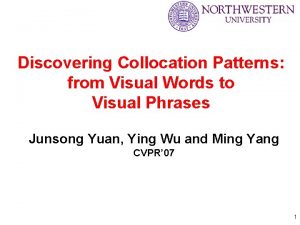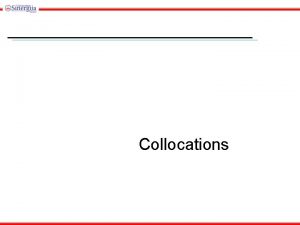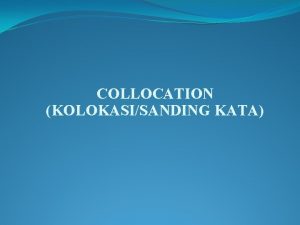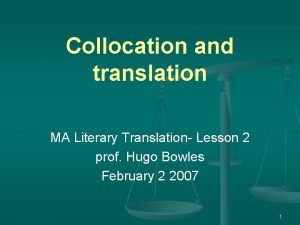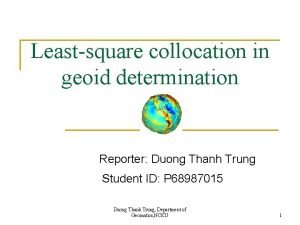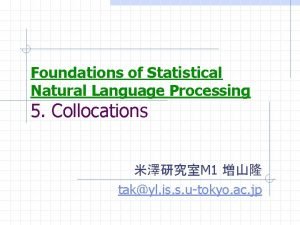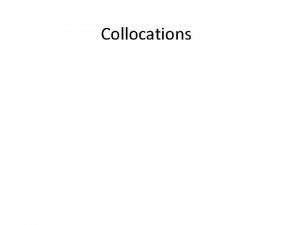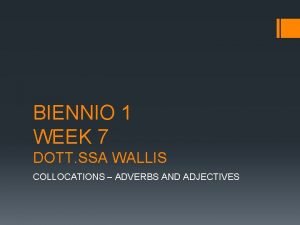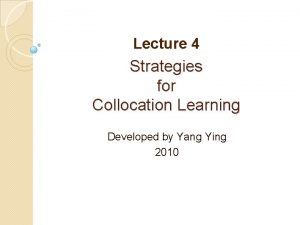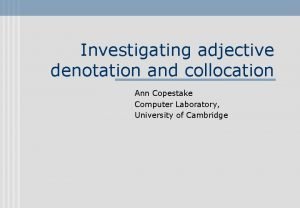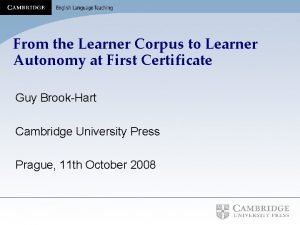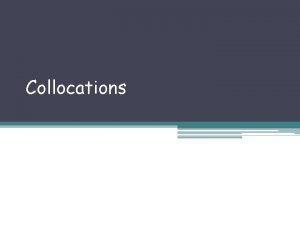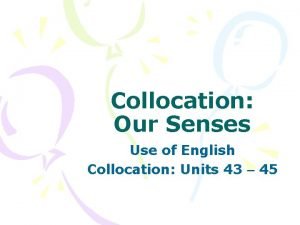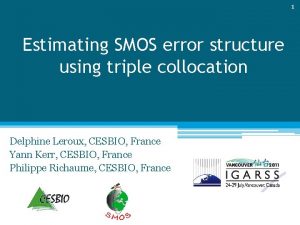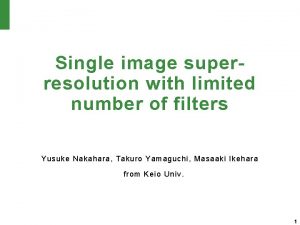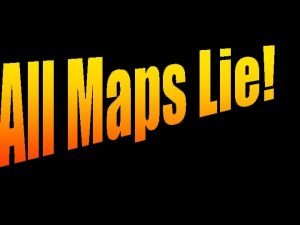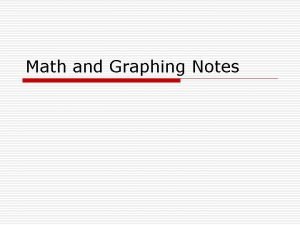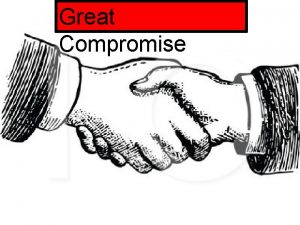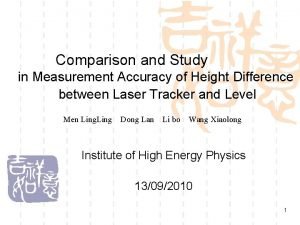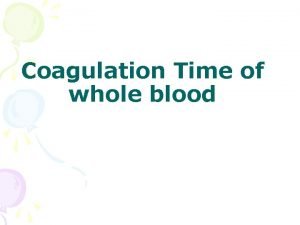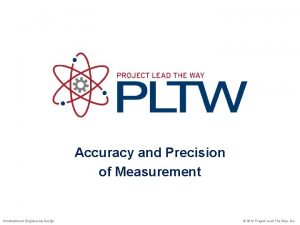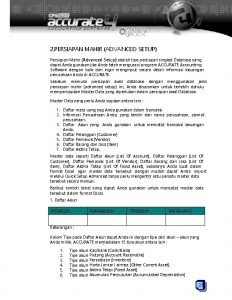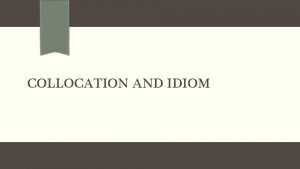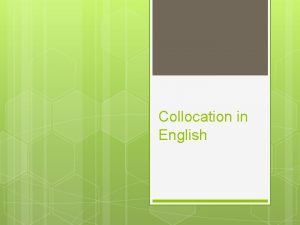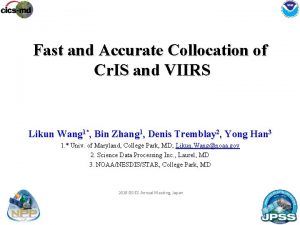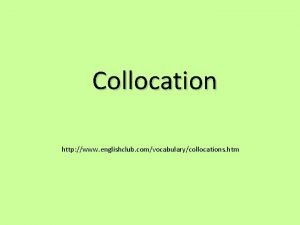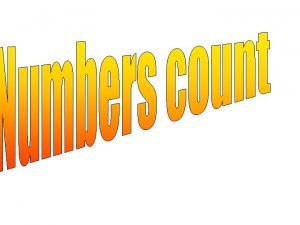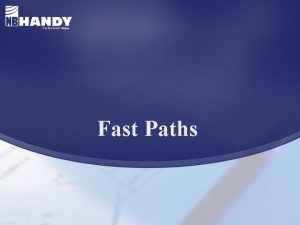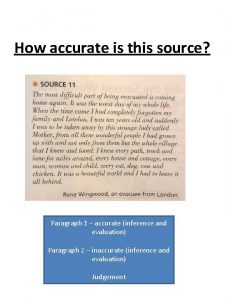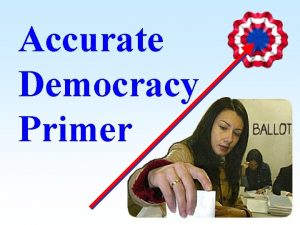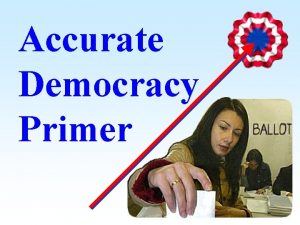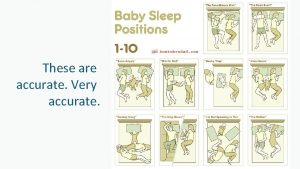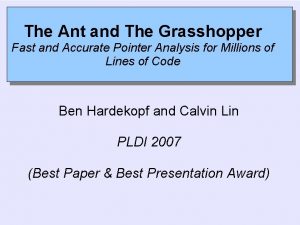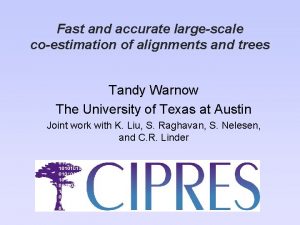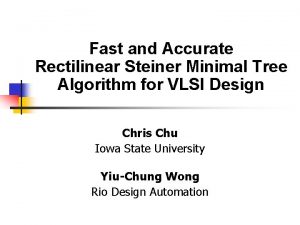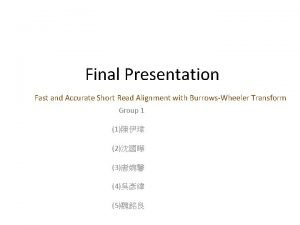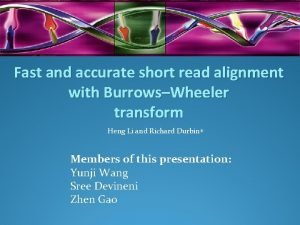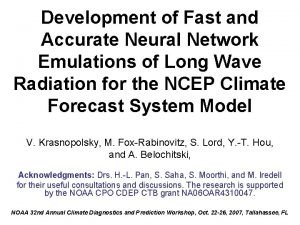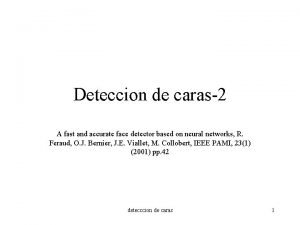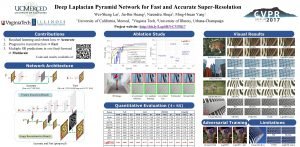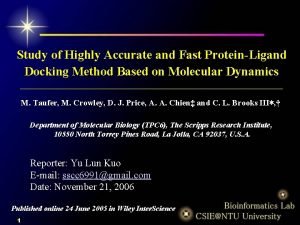Fast and Accurate Collocation of Cr IS and
































- Slides: 32

Fast and Accurate Collocation of Cr. IS and VIIRS Likun Wang 1*, Bin Zhang 1, Denis Tremblay 2, Yong Han 3 1. * Univ. of Maryland, College Park, MD; Likun. Wang@noaa. gov 2. Science Data Processing Inc. , Laurel, MD 3. NOAA/NESDIS/STAR, College Park, MD 2016 GSICS Annual Meeting, Japan

VIIRS Instrument 16 M-bands (750 m); 5 I-Bands (375 m); 1 DNB Band (750 m) Copied from Raytheon Website 2

Cr. IS Operational Concept Cr. IS on NPP ± 50° Cross track Scans RDR = Raw Data Record SDR = Sensor Data Record EDR = Environmental Data Record Do wn lin k RDRs 30 Earth Scenes Ground Station 2, 200 km Swath 3 x 3 Array of Cr. IS FOVs (Each at 14 -km Diameter) Decode Spacecraft Data Interferograms SDRs Cr. IS SDR Algorithm Calibrated / Geolocated Spectra EDRs Co-Located ATMS SDRs NWP, EDR Applications Global Temperature, Moisture, Pressure Profiles 3

Motivation land surface cloud properties Combination of Cr. IS Spectra and VIIRS Products NWP Data assimilations Physical parameter retrievals Inter-calibration Providing sub-pixel information for Cr. IS observations using collocated high-spatial resolution VIIRS products 4

Outline • Using Cr. IS and VIIRS as an example to explore general issues on collocation of two satellite sensors • Cr. IS and VIIRS are two independent instruments, though on the same platform – Not like IASI and AVHRR on Met. Op – No alignment requirements when design – Separate geolocation fields • Fast and accurate collocation algorithm suitable for operational use • Are Cr. IS and VIIRS perfect align together? – If not, collocated products can introduce errors and uncertainties, making data assimilation even worse. 5

VIIRS vs. Cr. IS: Spectrally Cr. IS spectra are overlapped with VIIRS SRFs for M 13, M 15, and M 16, and I 5 12. 0 µm 10. 8 µm 4. 05 µm 6

VIIRS vs. Cr. IS: Spatially VIIRS I 5 bands Cr. IS at 900 cm-1 Resolution: 375 m (I) or 750 m (M) 14. 0 km nadir Scan Angle: 58. 3° 48. 3 ° Sampling: Continuous Sub-sample 7

Collocation of Cr. IS with VIIRS Cr. IS Footprints Collocation of the measurements from two satellite sensors (either on the same satellite platform or not) involves pairing measurements from two sensors that observe the same location on the Earth but with different spatial resolutions. Cr. IS Footprints overlapped with VIIRS image It is challenging to do it on the Earth Surface using latitude and longitude. 1) Footprint rotation and distortion off nadir; 2) Searching! 8

Collocation of Cr. IS with VIIRS Using line-of-sight vector • It is better to collocate Cr. IS and VIIRS in space instead of on the Earth Surface • If we can retrieve line-of-sight vector of Cr. IS and VIIRS • The collocation of VIIRS and Cr. IS can be simplified as examining the angles between two vectors. – No worry about FOV distortion 9

Retrieve LOS Vectors Azimuth, Zenith, Range in Local Spherical Coordinate (East, North, Up) in meter in Local East, North, Up (ENU) Coordinate Geodetic Latitude, Longitude, and Altitude (LLA) Coordinate Earth-centered, earth-fixed (ECEF) Coordinate 10

K-D Tree Search In computer science, a k-d tree (short for k-dimensional tree) is a spacepartitioning data structure for organizing points in a k-dimensional space. Search Average Worst case O(log n) O(n) 11

Cr. IS Spatial Response Function 0. 963° 14. 0 km • Ideally, VIIRS images should be convolved with Cr. IS spatial response function. • Cr. IS detector response function: a cutoff value of ± 0. 963°/2 (14. 0 km at nadir) is about 41. 19% to its peak value but already collects 98% of total radiation falling on the detector. • The box-car spatial response is good enough to represent the real Cr. IS spatial response. VIIRS (Box Car Average) - (Spatial Response Convolution): ~0. 0023 K 12

Cr. IS-VIIRS BT Diff. Map Descending Ascending Large diff. can be seen at the end of scan 13

Misalignment between Cr. IS and VIIRS at the end of scan 14

VIIRS Geolocation Very Accurate ! (I 5 band: 375 m resolution) Wolf et al. 2013 from Wolf et al. 2013 Table 2. VIIRS Geolocation Accuracy First Update Second Update 23 February 2012 18 April 2013 Track mean − 24 m, − 7% 2 m, 1% Scan mean − 8 m, − 2% 2 m, 1% Track RMSE 75 m, 20% 70 m, 19% Scan RMSE 62 m, 17% 60 m, 16% Residuals 15

Cr. IS Geolocation Assessment Using VIIRS as a reference • The misalignment between Cr. IS and VIIRS can be caused by the Cr. IS geolocation error. Satellite • Can we use VIIRS as a reference to check Cr. IS geolocation accuracy? • The purpose is to identify the error VIIRS (Truth) characteristics of Cr. IS LOS pointing vector by comparing them with the truth. Cr. IS Earth Ellipsoid • Furthermore, if the systematic errors are found, a new set of coalignment parameters should be retrieved based on assessment results to improve the geolocation accuracy. 16

Overview of NPP/JPSS Geolocation Algorithms JPSS or any satellite Cr. IS (or other instrument) Coordinate transformation Interferometer COMMON GEO Spacecraft SSM Sensor Isolation system Spacecraft Orbital Function call to common geo: ellip. Intersect(out. Pt, inst 2 SC, exit. Vec, dlat, lon, satazm, satzen, range) feedback GEOLOCATION ASSESSMENT • GCP/Maps/Ground truth • the other instrument measurements with enough geolocation accuracy • Comparing the truth and Cr. IS Geo fields Modified from C. Cao Geolocate each FOV ECI ECEF(ECR) Geodetic ADCS Pos/Vel/Quaternion (RPY) Attitude Determination & Control System (ADCS) SGP 4

Retrieved the Cr. IS LOS vector relative to Spacecraft Satellite LOS vector in ECEF or ECR (lat , Lon) LOS vector in orbit frame LOS vector in S/C (satellite Pitch, Roll, and Yaw angle) (satellite velocity, geodetic nadir) + Triad Method Geolocation Fields (satellite range, azimuth, and zenith angle) the Earth 18

Defining α and β angles of Cr. IS LOS vector in Spacecraft Coordinate Y: Cross. Track X: In. Track β = atan(y/z) α = atan(x/z) Z: from satellite Pointing Earth Surface P: unit vector of LOS in SBF (x, y, z) 19

α and β Angles varying with Scan Position (FOV 5) β α Noted that the yaw patterns of angles are caused by the Earth Rotation when retrieving them in ECEF. 20

α and β angles are step-by-step perturbed by 21 steps with a angle of 375/833/1000. 0 α 21

Using VIIRS to find best collocation position FOR 30 22

Flowchart for VIIRS-Cr. IS Alignment Check Cr. IS LOS Vector in ECEF Cr. IS Geo. Field Cr. IS Sat_P and V in ECEF Compute LOS Vector in Orbit Frame Compute LOS Vector in S/C Frame Produce new Cr. IS LOS vector in SBF Perturb α and β angles with small angles Loop by 21 x 21 steps Output Collocated Results Convert Cr. IS LOS vector into ECEF Collocate VIIRS and Cr. IS VIIRS Geo. Field VIIRS Vector in ECEF 23

IDPS Data Geolocation Performance Cr. IS FOV size in-track and cross-track direction in-track direction cross-track direction This is root cause of misalignment between Cr. IS and VIIRS. 24

New Geometric Parameters SDR Algorithm Process 1) LOS in IOAR coordinate = ILS parameters (3 x 3) 2) Convert from IOAR to SSMF coordinate (2 angles) 3) Compute normal to SSM mirror in SSMF (30 Scan Pos) (60 angles) 4) Apply SSM mirror rotation to get LOS in SSMF coordinate 5) Convert from SSMF to SSMR coordinate (3 angles) 6) Convert from SSMR to IAR coordinate (3 angles) 7) Convert from IAR to SAR (3 angles) (3 angles 8) From SAR=> SBF coordinate (0 angels) Given the assessment results with 60 angles, the best strategy is to retrieve 60 scan mirror 9) From SBF=> Spacecraft (3 angles) rotation angles. 25

New SSMF In-track Angles New Values in Eng. PKT 26

Retrieved SSMF Cross-track Angles New -Eng. PKT New Values in Eng. PKT 27

Geolocation Performance (New Parameters) in-track direction cross-track direction Zoom in 28

Only correct cross-track direction 29

correct cross-track and in-track Direction 30

Another Validation Case Polar Region Cr. IS-VIIRS I 5 image IDPS New Codes + New Eng. Pkt 31

Conclusion • Line-of-sight based collocation to avoid FOV distortion • K-D tree based-search to speed up program • Cr. IS geolocation has been adjusted to perfectly align with VIIRS. • The method can work for other two sensors on different platform also. 32
 Example of acid-fast bacteria
Example of acid-fast bacteria Differentiate between acid fast and non acid fast bacteria
Differentiate between acid fast and non acid fast bacteria 20 collocation words
20 collocation words Flax corpus
Flax corpus Language search
Language search Collocation patterns
Collocation patterns Collocation approach
Collocation approach Contoh kata kolokasi
Contoh kata kolokasi Translation
Translation Determination collocation
Determination collocation Collocation nlp
Collocation nlp Degree collocation
Degree collocation What are collocations
What are collocations Acquire collocation
Acquire collocation Tourism collocation
Tourism collocation Lecture collocations
Lecture collocations Consultation collocation
Consultation collocation Restriction collocation
Restriction collocation Autonomy collocation
Autonomy collocation Integrate synonyms
Integrate synonyms Smell collocation
Smell collocation Bias collocation
Bias collocation Accurate cutting facilitates sewing and improve garment
Accurate cutting facilitates sewing and improve garment Comparative and superlative accurate
Comparative and superlative accurate Rapid and accurate image super resolution
Rapid and accurate image super resolution What is the most accurate representation of the earth?
What is the most accurate representation of the earth? Accurate feedback
Accurate feedback Sig fig checker
Sig fig checker Which best explains the need for the great compromise
Which best explains the need for the great compromise 60m height comparison
60m height comparison Capillary glass tube method for clotting time
Capillary glass tube method for clotting time Accuracy in measurement
Accuracy in measurement Advanced setup adalah
Advanced setup adalah


